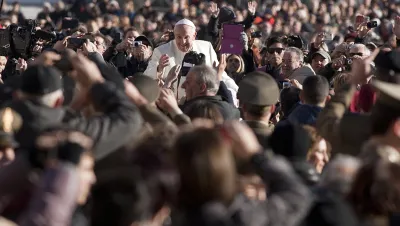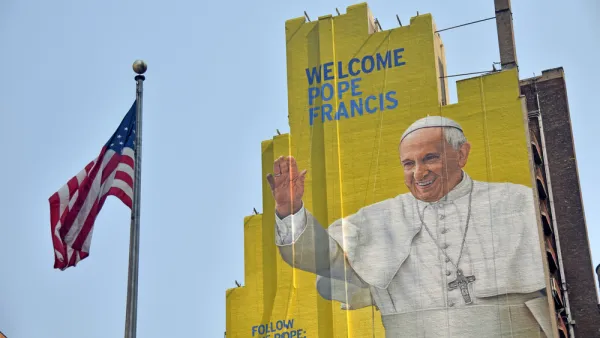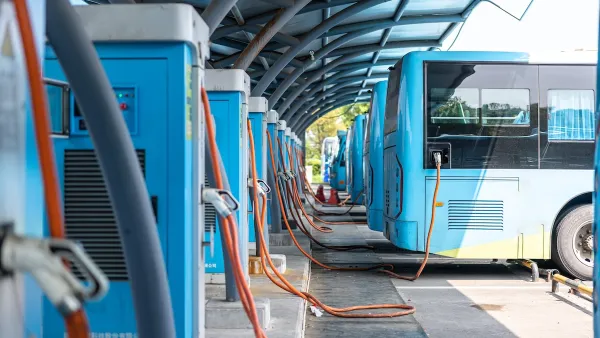Pope Francis's unprecedented focus on climate change and the environment includes strong messages for planners and designers of the built environment.

"Pope Francis on Thursday called for a radical transformation of politics, economics and individual lifestyles to confront environmental degradation and climate change, blending a biting critique of consumerism and irresponsible development with a plea for swift and unified global action," reports Jim Yardley and Laurie Goodstein in The New York Times.
Following the initial release of the encyclical, several planning and urbanism media outlets picked up on challenges offered to planners and designers of the built environment embedded in the message.
Andrew Stokols writes an article for TheCityFix that calls Pope Francis "the first urban pope" as well as "the first environmentalist pope." Stokols focuses especially on a passage from Chapter 1 (also titled "What is Happening to Our Common Home") of the encyclical, which reads:
"Nowadays, for example, we are conscious of the disproportionate and unruly growth of many cities, which have become unhealthy to live in, not only because of pollution caused by toxic emissions but also as a result of urban chaos, poor transportation, and visual pollution and noise. Many cities are huge, inefficient structures, excessively wasteful of energy and water. Neighbourhoods, even those recently built, are congested, chaotic and lacking in sufficient green space. We were not meant to be inundated by cement, asphalt, glass and metal, and deprived of physical contact with nature."
Writing for Next City, Anna Clark's take on the encyclical is Pope Francis's challenge to planners to build better cities for the poor. Clark focuses on a different passage from the same chapter:
"In some places, rural and urban alike, the privatization of certain spaces has restricted people’s access to places of particular beauty….In others, ‘ecological’ neighbourhoods have been created which are closed to outsiders in order to ensure an artificial tranquillity. Frequently, we find beautiful and carefully manicured green spaces in so-called ‘safer’ areas of cities, but not in the more hidden areas where the disposable of society live."
For the California Planning & Development Report, Josh Stephens describes Pope Francis as one of the world's foremost proponents of smart growth. Stephens focuses on a different chapter, titled "Ecology of Daily Life", which discusses the importance of communal living in cities that can asphyxiate citizens with overstimulation.
Finally for Grist, Ben Adler doubts that Pope Francis's position will have any impact on the political realities of climate change.
FULL STORY: Pope Francis, in Sweeping Encyclical, Calls for Swift Action on Climate Change

Analysis: Cybertruck Fatality Rate Far Exceeds That of Ford Pinto
The Tesla Cybertruck was recalled seven times last year.

National Parks Layoffs Will Cause Communities to Lose Billions
Thousands of essential park workers were laid off this week, just before the busy spring break season.

Retro-silient?: America’s First “Eco-burb,” The Woodlands Turns 50
A master-planned community north of Houston offers lessons on green infrastructure and resilient design, but falls short of its founder’s lofty affordability and walkability goals.

Test News Post 1
This is a summary

Analysis: Cybertruck Fatality Rate Far Exceeds That of Ford Pinto
The Tesla Cybertruck was recalled seven times last year.

Test News Headline 46
Test for the image on the front page.
Urban Design for Planners 1: Software Tools
This six-course series explores essential urban design concepts using open source software and equips planners with the tools they need to participate fully in the urban design process.
Planning for Universal Design
Learn the tools for implementing Universal Design in planning regulations.
EMC Planning Group, Inc.
Planetizen
Planetizen
Mpact (formerly Rail~Volution)
Great Falls Development Authority, Inc.
HUDs Office of Policy Development and Research
NYU Wagner Graduate School of Public Service



























